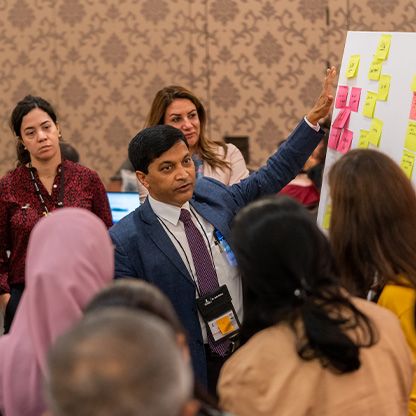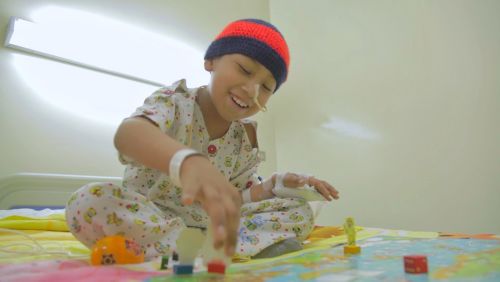St. Jude Family of Websites
Explore our cutting edge research, world-class patient care, career opportunities and more.
St. Jude Children's Research Hospital Home

- Fundraising
St. Jude Family of Websites
Explore our cutting edge research, world-class patient care, career opportunities and more.
St. Jude Children's Research Hospital Home

- Fundraising
Global Scholars: Dr. Wendy Cristhyna Gómez García
Other Global Scholars Projects:
Gómez García driven to help others in native Dominican Republic
Dr. Wendy Cristhyna Gómez García was about 7 years old when her mother took her to the hospital.
She wasn’t sick at the time. Rather, her mother had worked to raise donations for the pediatric oncology department at Dr. Robert Reid Cabral Children’s Hospital in Santo Domingo, Dominican Republic.
“What do you need?” Dr. Gómez García remembers her mother asking a pediatric oncologist. Their next step was to head over to a local pharmacy to buy a list of supplies. She still remembers the look of joy and appreciation when they dropped them back off.
“My mother tried to explain to me, ‘Look, these are kids that are very sick, that need support, and maybe we can try to do something. It’s not very big, but it’s something.’ So I learned that from her.” The moment was formative in another way, too. For Dr. Gómez García, it revealed that “all children weren’t as happy as me.”

“There’s a [saying] that you don’t look for St. Jude, that St. Jude picks you.” — Dr. Wendy Cristhyna Gómez García
As she grew older, she began pursuing a profession that would enable her to lend a hand.
“I wanted to help. I wanted to offer support to other people,” says Dr. Gómez García, who now works as the oncology unit coordinator at the very same hospital that she once visited with her mother. As she built her career in medicine, that spirit — What do you need? How can I help? — would become a hallmark of her approach.
When her mother worried that the family might not have enough money to pay for medical school, Dr. Gómez García told her not to worry, that she would earn a scholarship. And she did, to Instituto Tecnológico de Santo Domingo, from which she would graduate magna cum laude.
During medical school, she volunteered in the hospital during her vacations. And the same doctor who once gave her mother a list of the items that the pediatric oncology department needed from the pharmacy would become one of her most important mentors.
After graduating, Dr. Gómez García began to look around the Dominican Republic and wonder what else could be done for children with cancer. This question, in part, led her to a scholarship with St. Jude, and then a position, through the former International Outreach Program (the precursor to St. Jude Global), supporting patients in her native country. That experience began a longer-term association. “There’s a [saying] that you don’t look for St. Jude, that St. Jude picks you,” she says.
In 2021, Dr. Gómez García would return to St. Jude as a member of the third cohort of Global Scholars. From the start, she knew that she would focus her Scholars Project on palliative care.
Dr. Gómez García currently leads the first Onco-Pediatric Palliative Care Program in the Dominican Republic. “Since I returned [to Dr. Robert Reid Cabral Children’s Hospital] in 2012 to now, I’ve been doing palliative care by myself — just our oncology unit,” she says. “So we need support. I need more people engaged with the topic, more people knowing about palliative care, about taking care of pain in children.”
She points to a thesis that her team developed with two university students, examining why families seek care for their children at the emergency room. More than 60% of the children, she says, came with pain. “And what happens when they arrive to the emergency,” she adds, “doctors don’t know how to deal with pain. And the pain is not being taken seriously.”
Dr. Gómez García is working to spread awareness of the key principles of palliative care and to change misunderstandings that it just means end-of-life care. “No, no, no,” she says, “also a skin burn child is palliative. Also an ICU patient, it is palliative. The neurological. … All of them deserve palliative care. They deserve integral actions to have a better quality of life, for them and their families.”
She has focused her efforts on the next wave of clinicians: the students in residency training programs. “If we can work with them and share with them what is palliative care and the principal topics — the managing of pain, the managing of stressful symptoms, complex systems. … Maybe from that, we can spread to more [of] the hospital, this methodology.”
To work toward that end, Dr. Gómez García will begin her project with a preliminary survey to measure baseline understandings. From there, she and her colleagues will offer biweekly classes through the end of the academic year to members of the pediatric residency training program. These biweekly courses will use the EPEC academic course modules (Education in Palliative and End-of-Life Care). Afterward, they will conduct a follow-up survey to capture knowledge gains and attitude changes.
“And maybe, when we develop the proposal,” she says, “we can spread to other hospitals that have been hearing me about the topic, [where] somebody is saying: ‘I want to be part. I want to learn. I want to do something.’ So maybe we’ll have the opportunity to make it bigger and bigger, engage other institutions and maybe other countries.”
Her time in the Scholars Program, she says, has given her new points of view.
“It’s like having all this knowledge — but organized,” she says of the program. “Maybe we in our countries, in our settings, are leaders, are kind of champions — we have a lot of knowledge, a lot of studies about a lot of experience. But the master’s gives us the opportunity to organize all that information and expand with all the categories they give … about geopolitical health, global health, statistics, epidemiology — all the different stuff that is offered through the master’s and the leadership program.”
The leadership skills were particularly valuable, she says, … and timely. Just days before this interview, Dr. Gómez-García helped launch a National Strategic Plan for Childhood Cancer for the Dominican Republic.
“I feel very well like this is my dream,” she says. “Everything is going on. Everything is step by step. Maybe slowly, but everything is [becoming] a reality.”


